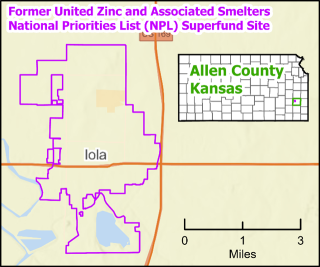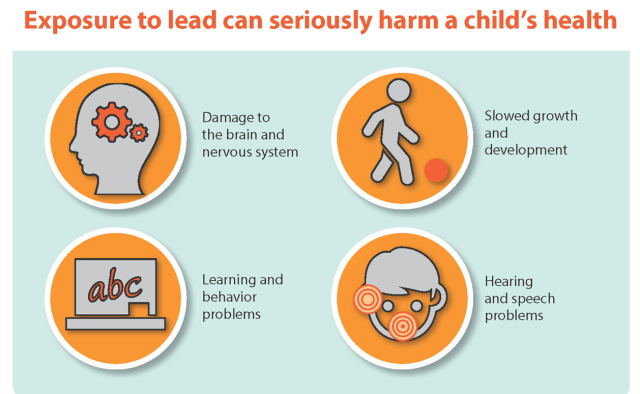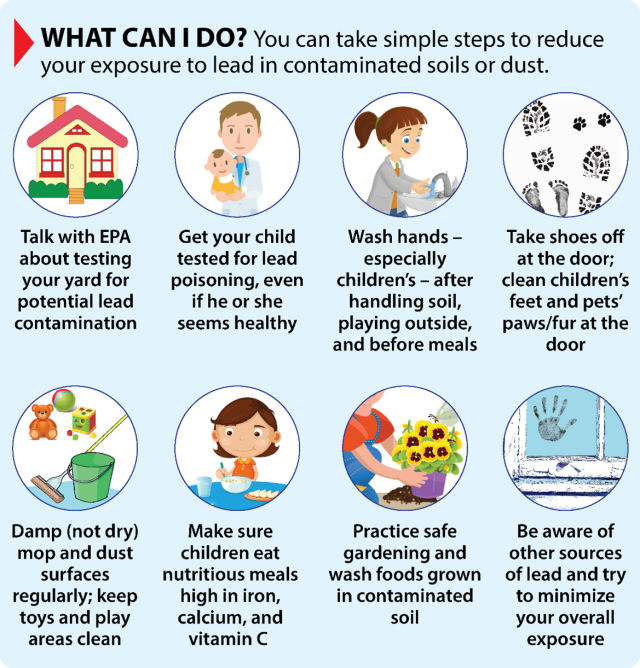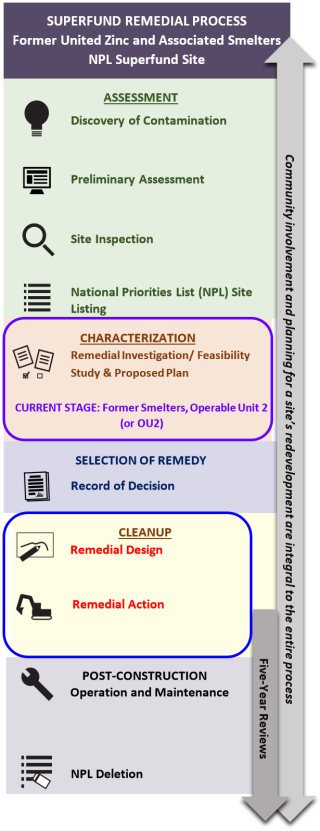Former United Zinc and Associated Smelters National Priorities List (NPL) Superfund Site, Iola, Allen County, Kansas - Fact Sheet, October 2023
EPA Announces Completion of First Five-Year Review
Overview of Five-Year Review

The U.S. Environmental Protection Agency (EPA) Region 7 is announcing the completion of its First Five-Year Review (FYR) of EPA’s Interim Record of Decision (ROD) for the Residential Yard Remedy (cleanup) at the Former United Zinc and Associated Smelters National Priorities List (NPL) Superfund Site (site). See small and large site maps at right. The National Priorities List is the list of sites of national priority among the known releases or threatened releases of hazardous substances, pollutants, or contaminants throughout the United States and its territories. Lead (Pb) is the main contaminant of concern at this site. Lead is a toxic metal that is harmful if inhaled or swallowed. It affects multiple body systems and is particularly harmful to children under 7 years old, as well as pregnant women and nursing mothers.
Five-Year Review Results and Site Status

After five years of implementing the remedy for cleaning up residential yards, EPA examined its effectiveness. See below for more information about the FYR process at Superfund sites. EPA found that the Residential Yard remedy (also known as Operable Unit 1, or OU1) is working as intended. Operable Units are different areas of a site, geographic or otherwise, where the remedial response action is subject to a different response decision and a separate Administrative Record. EPA’s approach at OU1 is expected to be protective of human health and the environment upon completion. The anticipated completion date of all residential yard remediation (also known as cleanup) is 2026. EPA will continue to test and clean up as many qualifying residential properties as possible.
Residential Yards (OU1):
To date, EPA has tested more than 2,955 properties for lead contamination in Iola and cleaned up over 1,100. Approximately 300 more residential properties qualify for cleanup. EPA will continue efforts to reach residents about the free lead testing and cleanup opportunity to protect children and families from lead poisoning.
Former Smelters (OU2):
In 2020, EPA began a Combined Remedial Investigation/Feasibility Study (RI/FS) for properties that were once used for metal smelting activities and have not already been redeveloped. RI: EPA will gather and analyze sampling results to assesses health and environmental risks. FS: EPA will evaluate cleanup options and seek input from the community in a Proposed Plan public comment period, once ready for review.
FREE Lead Testing and Cleanup Opportunity!

If your property has not been tested for potential lead contamination, please contact EPA (see below) and sign EPA’s access agreement (permission form) for free testing. If your residential property qualifies for cleanup, EPA will clean it up for FREE. Just sign EPA’s access agreement if it’s included with your testing results letter. Signing and returning the agreement allows the EPA contractor to start cleaning up the affected areas of the yard. Soil lead testing and remediation (cleanup) are free to property owners! Contact EPA today! Call toll-free 1-913-551-7747 or email: bahnke.donald@epa.gov.
Annual Childhood Blood Lead Testing
Some children in historic lead mining and smelting areas have elevated levels of lead in their blood. It is important that children under 7 years old have their blood lead level tested annually, because children suffering from lead poisoning do not always look or act sick. The only way to know if your child has elevated levels of lead in their blood is to have their blood tested. Talk to your pediatrician, general physician, or local health department about testing your child.
For more information, contact: SEK Multi-County Health Dept., 411 N. Washington, Iola, KS 66749 (phone: 620-365-2191); or the Agency for Toxic Substances and Disease Registry, Cory Kokko, regional representative; phone: 913-217-5981, email: ckokko@cdc.gov. To learn more about how to protect your family from lead hazards, visit EPA's Fact Sheet.
About Lead and Public Health

Lead is classified by EPA as a probable human carcinogen and is a cumulative toxicant that affects multiple body systems. Lead is dangerous to children because their growing bodies absorb more lead than adults do, and their brains and nervous systems are more sensitive to the damaging effects of lead. Lead exposure can cause a range of adverse health effects, including behavioral disorders, learning disabilities, and seizures, putting young children at the greatest risk because their brains and nervous systems are still developing. Learn more about lead on the CDC's Lead page and ToxFAQTM.
Site Background
The city of Iola was an international center for lead and zinc smelting until the end of World War I, with multiple smelters operating in Iola (and some in the adjacent towns of Gas and La Harpe). Most of the smelters in this area provided zinc for galvanizing; mined zinc was sent to the steel mills of Ohio, Pennsylvania, and New Jersey for further processing. Though lead was often not the primary metal being smelted, it was present as waste in the slag material. Smelting activities were conducted at the three facilities in Iola – Former United Zinc, East Iola, and IMP Boats – from 1896 to the 1920s. These facilities processed and smelted of ores containing lead, arsenic, cadmium, barium, and zinc.
About the Contamination and Cleanup
Heavy-metals contamination was deposited across the city of Iola from atmospheric deposition from smokestacks; atmospheric and water runoff from waste piles; the use of smelter wastes as road base and railroad ballasts; and as fill around houses, sidewalks, and driveways. Since 2005, EPA has been investigating and cleaning up lead contamination and other heavy metals found in soils at residential yards and child high-use areas – due to unacceptable human health risks. To date, EPA has tested 2,955 properties and cleaned up over 1,100 contaminated residential properties (including yards and child high-use areas such as child cares, parks, and playgrounds). A total of 170,210 tons of contaminated soil were removed from these areas and safely disposed of at the Allen County Landfill. EPA will continue to work cooperatively with state and local partners, especially on outreach to the community, health education, and controls needed to maintain the residential cleanups.
What is a Five-Year Review?

EPA conducts regular checkups, called Five-Year Reviews, on certain Superfund sites where cleanup completion is in process. FYRs are required by the Comprehensive Environmental Response, Compensation, and Liability Act (CERCLA), commonly known as Superfund, when hazardous substances remain on-site above levels that permit unrestricted use and unlimited exposure. FYRs provide an opportunity to evaluate the site’s remedy to determine if it remains protective of human health and the environment. As part of the FYR process, EPA published a notice of the FYR Start (2022) and Completion (2023) in the Iola Register. EPA also visited the site, inspected cleanup areas, and evaluated the environmental data collected for the site over the previous five years.
Information Repository
Site project information is available to the public at web repositories. To view the final Record of Decision (ROD), Administrative Records, Proposed Plan, and other cleanup documents, please visit EPA’s Site Profile page (see Site Documents & Data). If you do not have internet access, documents are also available during normal business hours online at the following locations:
Iola Public Library
218 E. Madison Ave.
Iola, KS 66749
620-365-3262
EPA Region 7 Records Center
11201 Renner Blvd.
Lenexa, KS 66219
1-800-223-0425
Technical Assistance Grant
To help affected communities understand the technical information related to a Superfund site, EPA established a Technical Assistance Grant (TAG) Program. Grants provide up to $50,000 for a qualified citizens’ group to hire an independent technical advisor. Advisors can help citizens interpret technical data, understand site actions, hazards, and different cleanup technologies.
EPA Contact Information
Don Bahnke
Remedial Project Manager
U.S. EPA Region 7 (SEMD/LMSE/MSRS)
11201 Renner Boulevard
Lenexa, KS 66219
Email: bahnke.don@epa.gov
Phone: 913-551-7747
Toll-free: 1-800-223-0425
Elizabeth Kramer
Community Involvement Coordinator
U.S. EPA Region 7 (ORA/OPA)
11201 Renner Boulevard
Lenexa, KS 66219
Email: kramer.elizabeth@epa.gov
Phone: 913-551-7186
Toll-free: 1-800-223-0425
